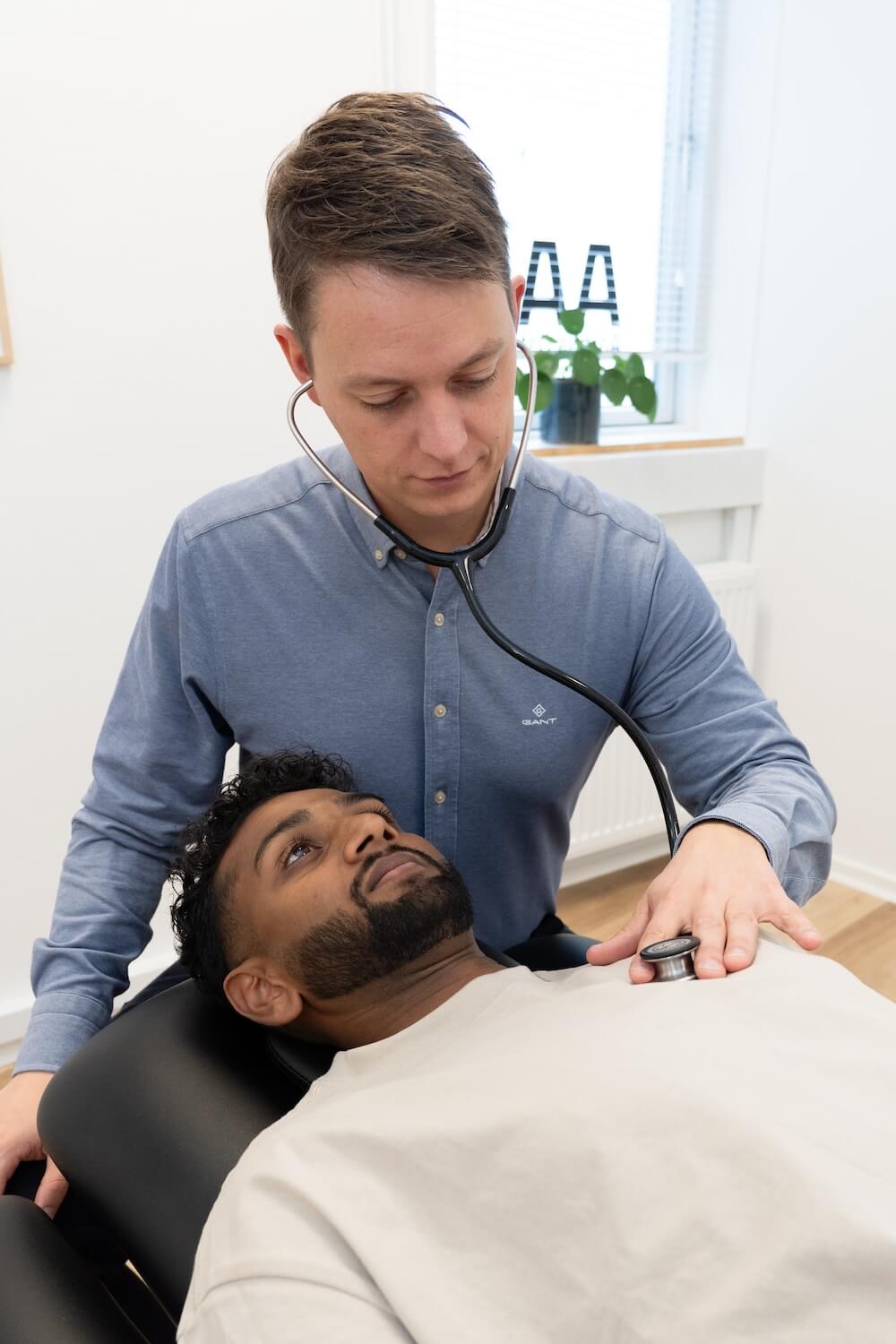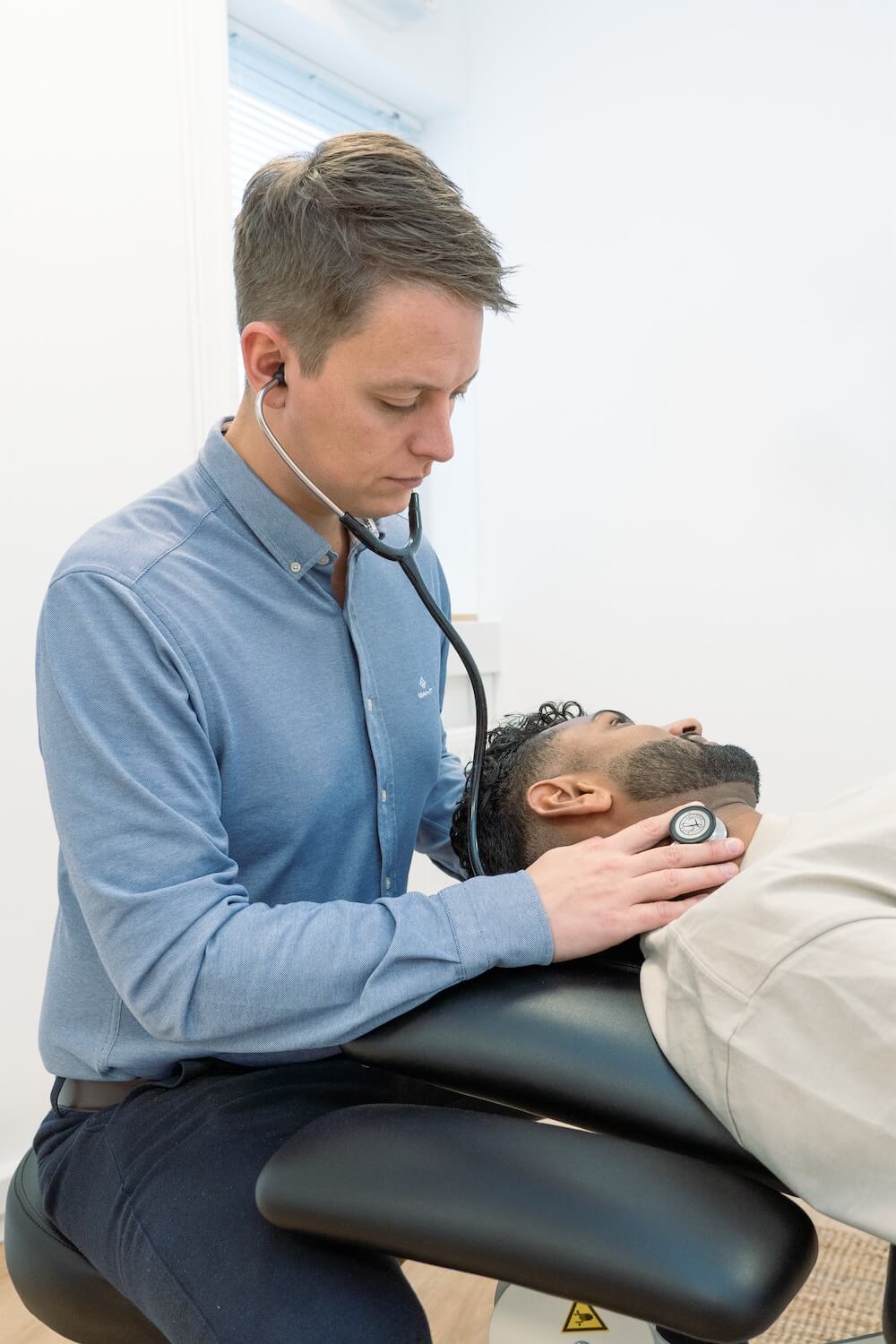We treat
Diabetes mellitus
Learn more about Diabetes mellitus
What is diabetes mellitus?
Diabetes, also known as diabetes mellitus, is a chronic metabolic disease characterized by elevated levels of glucose (sugar) in the blood. This condition occurs when the pancreas either does not produce enough insulin or when the body’s cells become resistant to insulin. Unregulated blood sugar levels can lead to a number of serious health problems over time.
Jump to section [Vis]
Types of diabetes: Type 1, Type 2, and gestational diabetes
There are several types of diabetes. Here are three of the most common:
Type 1 diabetes:
This is an autoimmune disease in which the body’s own immune system attacks and destroys the insulin-producing beta cells in the pancreas. The result is a lack of insulin, which is needed to transport sugar to muscles and fat tissue. Type 1 diabetes is often diagnosed in childhood or adolescence, but can occur at any age. People with type 1 diabetes rely on daily insulin injections to keep their blood sugar levels under control.
Type 2 diabetes:
This is the most common form of diabetes. In type 2 diabetes, the pancreas still produces insulin, but the body’s cells, especially in muscle and fat tissue, become resistant to insulin. This means that less sugar is transported into the cells. Type 2 diabetes is closely linked to being overweight, physical inactivity and genetic factors. The condition often develops gradually and is typically diagnosed in adulthood.
Gestational diabetes (pregnancy-related diabetes):
This type of diabetes is similar to type 2 diabetes, but it occurs during pregnancy. It is caused by the body not being able to produce enough insulin to meet the increased needs of both the mother and the fetus. Gestational diabetes usually disappears after birth, but increases the risk of developing type 2 diabetes later in life, for both the mother and the baby.

Causes and risk factors for diabetes
Type 1 diabetes is primarily caused by autoimmune factors, where the immune system attacks and destroys the insulin-producing beta cells in the pancreas. The reason why some people develop type 1 diabetes is not entirely clear, but the disease is thought to be caused by an interaction between environmental factors, possibly viral infections, and genetic predispositions.
Type 2 diabetes is more closely linked to lifestyle factors such as obesity, physical inactivity and unhealthy diet. Genetic factors and certain medications, such as corticosteroid, can also increase the risk of developing type 2 diabetes.
Gestational diabetes shares some of the same lifestyle and hereditary risk factors as type 2 diabetes, but is also associated with hormonal changes during pregnancy. The risk is increased by previous cases of gestational diabetes, previous birth of a baby weighing more than 4.5 kg, and pregnancy with twins.
Symptoms and signs of diabetes
The symptoms of diabetes can vary depending on the type and progression of the disease, but some of the most common symptoms include:
- Increased thirst and frequent urination: High blood sugar levels cause the kidneys to work harder to filter and absorb excess sugar, which can lead to increased thirst and more frequent urination.
- Extreme fatigue: When cells cannot use glucose for energy, it can result in a feeling of exhaustion and tiredness.
- Blurred vision: High blood sugar can pull fluid out of the eyes, which can lead to blurred vision.
- Unexplained weight loss: Although there may be increased hunger, weight loss may occur. Without adequate insulin, the body may begin to break down muscle and fat stores for energy, leading to weight loss, especially in type 1 diabetes.
- Frequent infections and slow wound healing: Diabetes can weaken the immune system and decrease blood circulation, making it easier to get infections and can inhibit the healing of wounds, especially on the lower extremities.
Diagnostic methods and tests for diabetes
The diagnostic tests for diabetes vary depending on the type, and there are also methods other than those described below:
- Type 1 diabetes: The diagnosis is often made quickly by acute blood sugar measurement, as symptoms appear quickly and there is a risk of acidosis, which can be life-threatening. To confirm the diagnosis and determine the type, blood tests are performed, typically measuring C-peptide and GAD antibodies.
- Type 2 diabetes: The diagnosis is made by the HbA1c test, which measures “long-term blood sugar” over the past 2-3 months. If the HbA1c value is above 48 mmol/mol on two or more measurements, the person is diagnosed with diabetes.
- Gestational diabetes: When suspected or screened for gestational diabetes, the oral glucose tolerance test (OGTT) is often used. This test involves measuring blood sugar levels before and two hours after consuming a sugar-water mixture containing 75 grams of glucose. If blood sugar levels rise above 11.0 mmol/L and there are symptoms of the disease, this indicates diabetes. For gestational diabetes, the diagnosis is made at a blood sugar level of 9.0 mmol/L or higher.

Complications associated with poorly controlled diabetes
Untreated or poorly controlled diabetes can lead to a number of serious complications:
- Cardiovascular disease: Diabetes increases the risk of many different cardiovascular diseases due to damage to the heart and blood vessels from long-term high blood sugar. People with diabetes are at increased risk of atherosclerosis, heart attacks, and bleeding or blood clots in the brain.
- Diabetic neuropathy (diabetic nerve inflammation): Over time, high blood sugar can damage the nerves, especially in the feet, and can spread to the lower legs. Symptoms may include decreased sensation, prickling or tingling in the skin, pain, cold or hot sensations, and dry skin in the legs. In other parts of the body, symptoms may include dizziness, stomach and intestinal problems, chronic diarrhea, and difficulty urinating. Diabetic neuropathy can be divided into two types: chronic and persistent, and acute neuropathy, which occurs suddenly and may go away.
- Nephropathy (kidney disease): Poorly controlled diabetes can damage the small blood vessels in the kidneys. Nephropathy is one of the most common reasons for the need for dialysis.
- Retinopathy (eye disease): Long-term high blood sugar can damage the small blood vessels in the retina. Symptoms of eye damage can include blurred vision and sudden changes in vision.
- Foot problems: Poor circulation and nerve damage in the legs can lead to slow-healing wounds. In severe cases, these wounds can develop into infections that may require amputation.
Treating and Managing Diabetes: Insulin, Medication, and Diet
Treatment for diabetes depends on the type and includes a combination of medication, lifestyle changes, and regular monitoring of blood sugar levels:
- Insulin therapy: For patients with type 1 diabetes and some with type 2 diabetes, insulin therapy is essential. Insulin can be administered using a syringe, insulin pen, or insulin pump. Insulin is typically given about 30 minutes before a meal or in the event of an elevated blood sugar reading.
- Antidiabetic drugs: These medications are often used to treat type 2 diabetes. The primary goals of this treatment are to keep blood sugar levels within normal limits and prevent the development of diabetic complications. Antidiabetic drugs often come in the form of tablets or pills and work in different ways to improve the body’s ability to regulate blood sugar. Some of the newer antidiabetic drugs have also been shown to be kidney and heart protective.
- Diet and exercise: A healthy diet and regular physical activity are key to managing diabetes. A diet low in sugar and saturated fat but high in fiber helps stabilize blood sugar levels. Exercise improves overall health, blood sugar balance, and body composition, as well as reducing the risk of diabetes-related complications and cardiovascular risk factors.
Regular monitoring of blood sugar levels is also important to adjust treatment and ensure that blood sugar levels remain within the desired range.
Osteopathy and diabetes
Osteopathy offers a holistic approach to treating diabetes by focusing on improving the body’s structural balance and function. While osteopathy cannot cure diabetes, it can act as a non-medical adjunct to relevant medical treatment and support general well-being.
- Support, advice and guidance: Osteopaths can offer valuable advice on lifestyle changes that can reduce stress on the body, strengthen the immune system and improve hormone regulation. This may include recommendations for diet, exercise and stress management techniques, which can contribute to better control of diabetes and overall health.
- Increase mobility and function: Osteopathy focuses on improving mobility throughout the body, which can be especially helpful for people with diabetes who may experience muscle and joint pain. Diabetes increases the risk of conditions such as frozen shoulder, trigger finger, and carpal tunnel syndrome, which are often related to connective tissue in joint capsules, tendons, and subcutaneous tissue. Osteopathic treatment can help alleviate these problems and improve mobility.
- Hormone production and blood circulation: Osteopathic treatment often addresses the body’s blood circulation, which is essential for the health of the entire body. By improving circulation, especially to the lower legs and feet, osteopathic techniques such as manual therapy and manipulative techniques (OMT) can be helpful. Treatments that focus on the pancreas and the autonomic nervous system can potentially improve pancreatic function through improved blood circulation and stimulation of the parasympathetic nervous system.
This approach can be a useful part of a comprehensive diabetes treatment plan that also includes medication, dietary changes, and exercise. It is important that osteopathic treatment is used as a supplement to, and not as a substitute for, conventional medical treatment.

Prevention of diabetes-related complications
Preventing complications and diabetic sequelae requires a comprehensive approach to diabetes management and ongoing health monitoring. Here are some of the most important strategies:
Regular Monitoring:
-
- Self-monitoring of blood sugar: Daily blood sugar testing is essential for adjusting treatment and ensuring that blood sugar levels remain within the normal range. This helps adjust insulin or medication dosage and detect any problems early.
Healthy Lifestyle:
-
- Balanced Diet: A diet rich in fiber, low in sugar and saturated fat, and balanced with proteins and complex carbohydrates, is important for keeping blood sugar levels stable.
- Regular Exercise: Physical activity helps control blood sugar, improve insulin sensitivity, and maintain a healthy weight. Exercise can also improve heart health and reduce stress.
- Weight control: Maintaining a healthy weight is critical for preventing complications, especially in type 2 diabetes, where being overweight can worsen insulin resistance.
Medical Follow-up:
-
- Regular Doctor Visits: Frequent consultations with a doctor are necessary to monitor kidney function, circulatory system, eyes, and other areas that can be affected by diabetes. This ensures that any complications are detected early and treated effectively.
- Specialist visits: Depending on symptoms and needs, you may need to be referred to specialists such as an ophthalmologist, nephrologist, or cardiologist.
Smoking and Alcohol:
-
- Avoid Smoking: Smoking increases the risk of cardiovascular disease and can worsen diabetes complications. Quitting smoking is an important part of diabetes management.
- Limit Alcohol Consumption: Alcohol can affect blood sugar control and interact with diabetes medications. It is important to drink in moderation and be aware of how alcohol affects blood sugar.
These strategies work together to improve overall diabetes control and reduce the risk of serious complications. An integrated approach that combines medical treatment with lifestyle changes is the most effective way to manage diabetes and prevent complications.
Recommendations on diet and exercise
Diet and exercise are fundamental to effective diabetes management, and their importance cannot be underestimated. Here are some of the most important guidelines and recommendations:
Dietary advice for people with diabetes:
- Eat Plant-Based, Varied, and Not Too Much: Focus on a balanced diet with a wide variety of foods.
- Eat More Vegetables and Fruits: Increase your intake of vegetables and fruits to get essential vitamins, minerals, and fiber.
- Eat Less Meat – Choose Legumes and Fish: Reduce meat consumption and include plant-based protein sources as well as fish.
- Eat Whole Grain Foods: Whole grains contain more fiber and nutrients compared to refined grain products.
- Choose Plant Oil and Low-Fat Dairy Products: Switch to plant oils like olive oil and choose low-fat dairy products to reduce saturated fat intake.
- Eat Less of the Sweet, the Salty, and the Fatty: Limit your intake of sugary, salty, and high-fat foods.
- Quench Your Thirst with Water: Drink water as your primary fluid to avoid extra sugar and calories from sugary drinks.
Exercise
Regular physical activity:
- Recommendation: Aim for at least 30 minutes of moderate intensity exercise daily. This could be brisk walking, cycling, swimming, or other activities that make you feel a little out of breath.
- Benefits: Exercise improves insulin sensitivity, helps with weight loss and maintenance of a healthy weight, and may reduce the risk of heart disease and other complications related to diabetes.
- Variety: Integrate both cardiovascular exercise (like walking and cycling) and strength training (like weightlifting or yoga) for a balanced workout routine.
Integration in Diabetes Treatment
A combination of a healthy diet and regular exercise can help to:
- Controlling Blood Sugar Levels: A well-balanced diet and regular exercise are essential to keep blood sugar levels stable and prevent major fluctuations.
- Improve Insulin Sensitivity: Exercise makes it easier for the body to use insulin effectively, and a diet rich in fiber and low in sugar helps control blood sugar.
- Prevent Complications: A healthy lifestyle can reduce the risk of diabetes-related complications such as cardiovascular disease, neuropathy, and retinopathy.
By following these diet and exercise guidelines, people with diabetes can support their treatment and improve their quality of life.

Living with diabetes: Self-monitoring, education, and support
Living with diabetes requires a comprehensive approach that includes self-monitoring, education, and support. Here’s an in-depth overview of each of these aspects:
Self-monitoring
The Importance of Self-Monitoring:
- Regular Blood Sugar Monitoring: Frequent blood sugar monitoring helps ensure that it is kept within the recommended range. This can be done using a blood sugar meter, which can be handheld or integrated into an insulin pump.
- Technological Solutions: Modern solutions exist such as continuous glucose monitors (CGMs), which measure blood sugar levels around the clock and sends data to a smartphone or insulin pump, making it easier to monitor and adjust treatment in real time.
- Blood tests: Traditional methods involve taking a small drop of blood from a finger. It is important to follow the instructions to get accurate readings and maintain proper hygiene.
Education
The Importance of Patient Education:
- Dietary awareness: Understanding how different foods affect blood sugar is critical. Learning about carbohydrates, the glycemic index, and how to compose meals can help regulate blood sugar levels.
- Medication Adjustment: Patients need to learn how to adjust insulin or medication doses based on blood sugar readings, meals, physical activity, and other factors.
- Managing Complications: Education on how to recognize and manage symptoms of diabetes-related complications such as hypoglycemia (low blood sugar) and hyperglycemia (high blood sugar) is essential.
- Health Professional Assessment: Knowledge of when to seek professional help and how to communicate effectively with health professionals can improve treatment outcomes.
Support
The Importance of Support:
- Family and Friends: Support from loved ones can be essential in managing the daily challenges of diabetes. They can help maintain healthy habits and motivate you to make lifestyle changes.
- Healthcare professionals: Regular consultations with doctors, diabetes nurses, nutritionists, and other specialists are important to customize treatment and monitor diabetes management.
- Support groups: Participating in support groups can offer social support, sharing experiences, and practical advice. It can help you understand that you are not alone in your experience with diabetes and provide a forum for exchanging strategies and encouragement.
Resources and Support:
- Online Communities: Many people with diabetes find support in online groups and forums where they can get advice and share their experiences.
- Diabetes Associations: Local and national diabetes associations offer information, advice, and support programs that can be a valuable resource.
- Health apps: There are apps that help track blood sugar, diet, and medication and can offer reminders and motivation.
By integrating these elements into the treatment strategy, people with diabetes can achieve better control of their disease, prevent complications, and improve their quality of life.
Sources:
https://videncenterfordiabetes.dk/viden-om-diabetes/type-1-diabetes
https://videncenterfordiabetes.dk/viden-om-diabetes/type-2-diabetes
https://videncenterfordiabetes.dk/viden-om-diabetes/graviditetsdiabetes
https://videncenterfordiabetes.dk/viden-om-diabetes/andre-typer-diabetes
https://videncenterfordiabetes.dk/viden-om-diabetes/type-2-diabetes/foelgesygdomme
https://videncenterfordiabetes.dk/viden-om-diabetes/type-1-diabetes/foelgesygdomme
https://videncenterfordiabetes.dk/viden-om-diabetes/graviditetsdiabetes/risiko-for-mor-og-barn
https://endocrinology.dk/Blodglukoserapport.pdf
https://endocrinology.dk/nbv/diabetes-melitus/type-1-diabetes-mellitus/
https://gynobsguideline.dk/wp/wp-content/uploads/2013/02/GDM-Sandbjerg-2014-godkendt-2014.pdf
https://endocrinology.dk/nbv/diabetes-melitus/behandling-og-kontrol-af-type-2-diabetes/
https://endocrinology.dk/kliniske%20retningslinier%20-%20GDM.pdf
https://www.ncbi.nlm.nih.gov/books/NBK559051/
https://videncenterfordiabetes.dk/viden-om-diabetes/diabetes-og-psyken
https://videncenterfordiabetes.dk/viden-om-diabetes/type-1-diabetes/behandling
https://videncenterfordiabetes.dk/viden-om-diabetes/type-2-diabetes/behandling
https://videncenterfordiabetes.dk/viden-om-diabetes/graviditetsdiabetes/behandling

Often related pain

Kissing disease

Diabetes mellitus

Eye inflammation

Padel injuries

Sedentary work

Nicotine and exercise

Shingles

